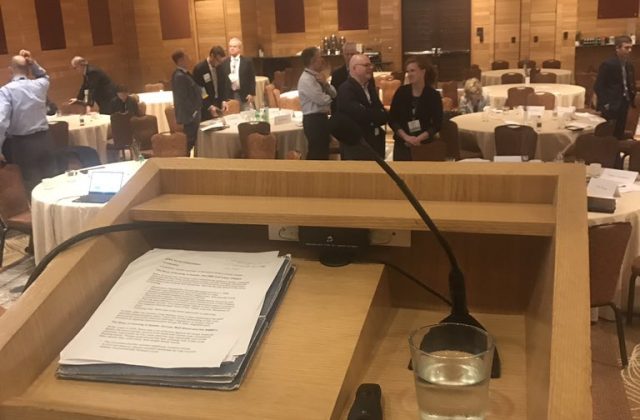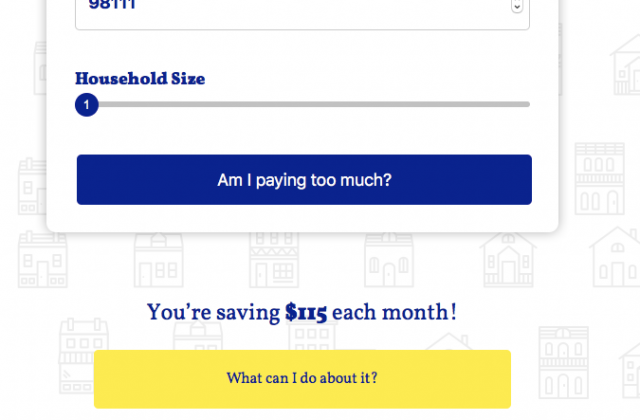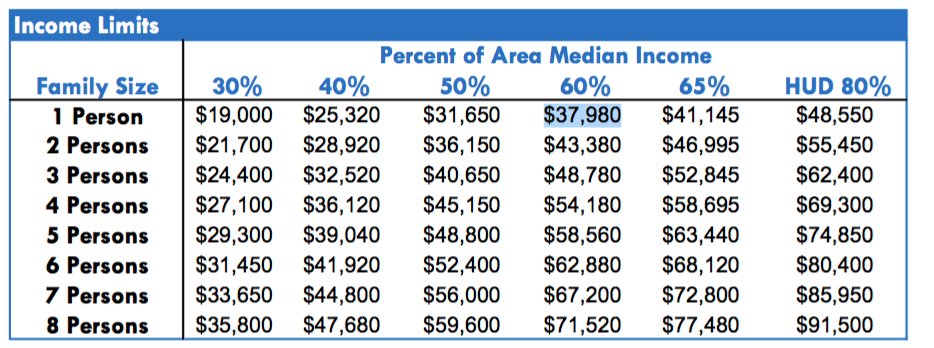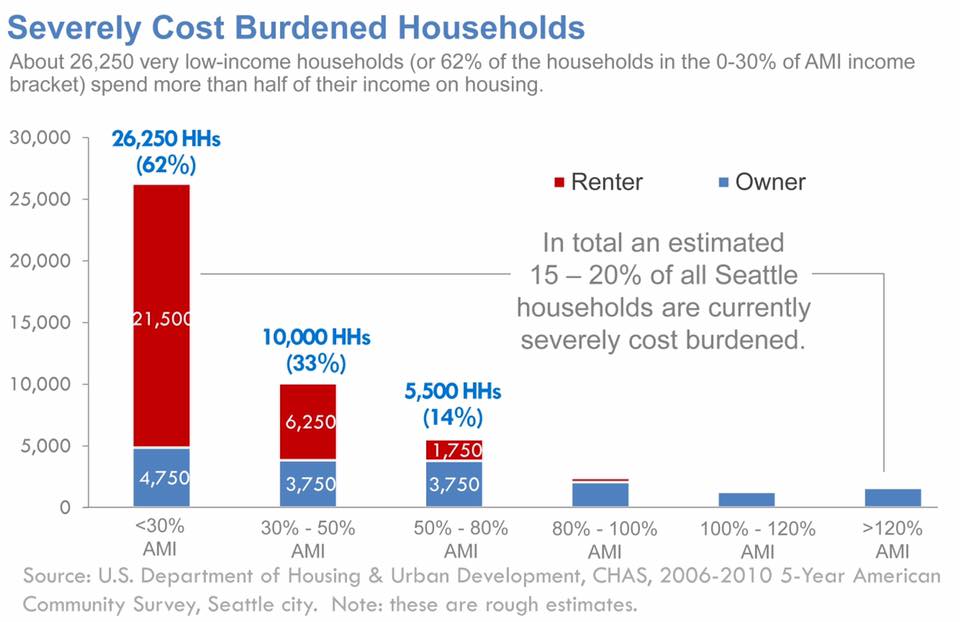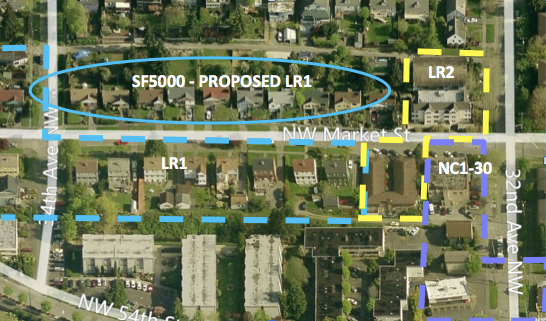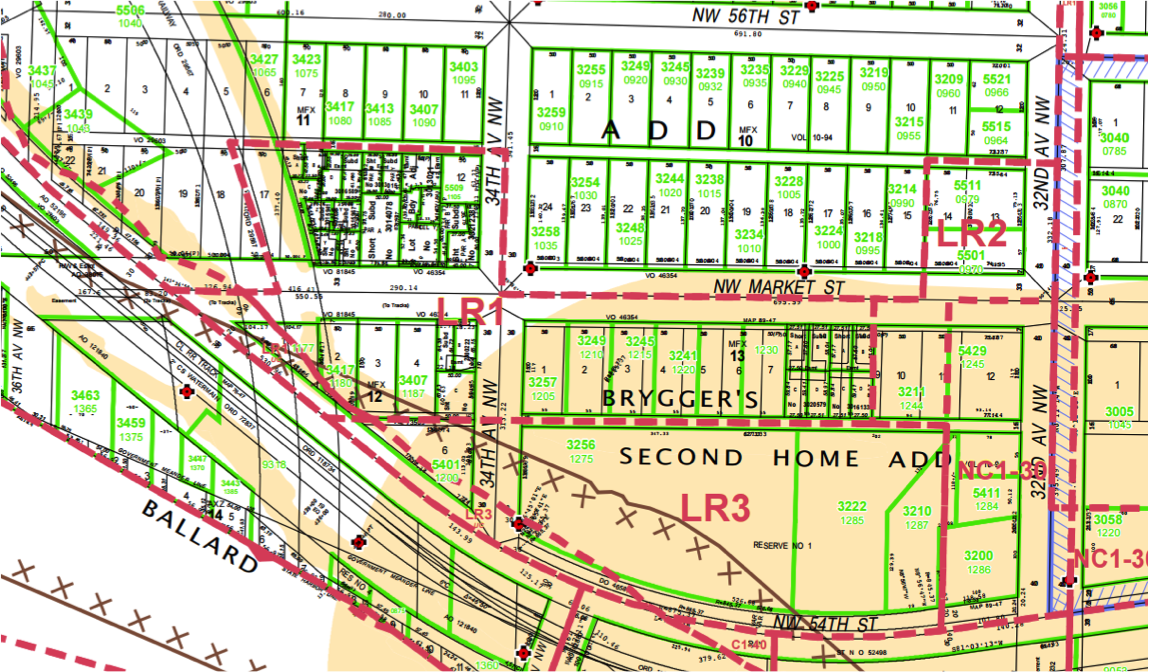ULI Presentation: The State of the Housing Debate in Seattle
Last week I was invited to address the Council on Small Scale Development Council at the Urban Land Institute’s Spring meeting held here in Seattle. I don’t like Power Point presentations. In general, I feel like what’s happening on the screen distracts from what’s being said, and what’s being said can distract from the slides. On the other hand, it’s a powerful tool in some settings. My slides are minimal here so I’ve included my talking notes at the bottom. My message to the group was simply this: Seattle is about to drive off a cliff with Mandatory Inclusionary Zoning that will send us into a spiral of higher housing prices, more restrictive regulation inspired by those prices, and more higher prices. Before this I gave a 25 year history of growth and how we’ve dealt with it up until now.
Notes for ULI Presentation
Introduction
I’ll introduce myself, and then I’ll talk about Smart Growth Seattle.
The Story of Housing in Seattle: The GMA and Urban Villages
Many of us got into all things urban because we believed dense, walkable cities are the best thing we’ve got to counter climate change, prevent the degradation of the environment, have a vibrant economy and even learn more about other people and ourselves. Now all we talk about is the price of housing.
- Washington Passed the Growth Management Act in 1989
- The plan was designed to put more growth in cities
- Seattle’s approach was an Urban Village plan, with growth being poured into areas already zoned for density
- This was the original “Grand Bargain;” single-family would be left untouched in exchange for growth and infrastructure in the villages.
- The City also offered a lot of staff support and there were numerous committees, groups, and stewardship efforts in the neighborhoods.
- This balance held through most of the 1990s until the recession of 2001
- Following that, there was a top down approach to planning.
In 2001, after the election Greg Nickles more or less disbanded the staff and the implementation effort. I liken this to the disbanding of the Iraqi army at the end of the Second Gulf War; neighbors no longer had a structure to organize around positive things for their neighborhood.
The Story of Housing in Seattle: Occupy Wall Street and the NIMBYs
At the crash in 2008, there was a lot of foment against all things financial. Banks, the stock market, anyone who dealt with money was considered criminally responsible for the crash, and this was especially true of the housing sector. People experienced the fear of losing one of the most basic assets they could have, their single-family house.
- The Occupiers and the worried neighbors combine forces
- In 2013 an obscure, openly socialist candidate for City Council defeats Councilmember Richard Conlin
- The Council begins a leftward lurch driven largely by neighbors angry and worried about new development, the extreme left leaning supporter of Councilmember Sawant, and those worried about the rising price of housing.
- Together this coalition has created an environment in which interventions in the housing market must be punitive: developers much “pay their fair share” for creating so much housing and commercial space.
- Along with numerous other supply killing initiatives, the centerpiece of the effort to Make Housing Affordable Again is Mandatory Inclusionary Zoning, an infeasible, inflationary and, in the end, illegal program of mandated rent restricted housing or fees in lieu.
- This effort was driven largely by non-profit housing developers who want access to more capital to build units
The Story of Housing in Seattle Today: Units! Units! Units!
In Seattle today the solution to rising prices is to squeeze cash out of the production of market rate housing to build thousands of subsidized units. What’s ironic about this, obviously, is that this won’t do anything beneficial to upward price pressures. On the contrary, this, along with other limitations on production, is a recipe for higher prices, which will lead to more unhelpful intervention.
What’s the Better Solution? More Housing! And Smarter Subsidies
The market can produce an enormous number of market rate units with good incentives. Also, with broad and wide taxation, especially of land inefficiency (think of 5000 or 7200 square foot lots with two people on them) we could also generate money for subsidies that should take the form of direct cash payments or tax abatement for rent restrictions in some as a voluntary incentive program.
Do You Need Help With Rent? Try Our Calculator
I’ve been making the point that we could make our resources go a lot further if we just make direct cash payments to people who need help with rent. So we decided to make a calculator that would show renters just how much more than the normative standard they are paying using a simple calculator at helpmewithrent.com. The point of this is to show people just how much they are overpaying rent or how “cost burdened” they really are by taking their rent and then comparing that to their income and then calculating whether the renter is paying more than 30 percent of their income on rent. If they are, they’re paying too much. Shouldn’t the City just use levy money and other subsidies to pay that difference? Wouldn’t that be more efficient? The devil is in the details but the calculator, we hope, might get people thinking that instead of complaining about a housing crisis, the City should just help with rent. Check out the site.
Here’s the text on the page after a renter calculates their rent.
Federal, state, and local government have decided that you should pay no more than 30 percent of your total monthly income on housing costs. If you earn $36,000 per year, or $3,000 per month, for example, you shouldn’t pay more or less than $1,000 for rent. How did government arrive at this number? It’s really a mystery. But it’s the standard that is applied for housing affordability all over the United States and here in Seattle.
How does the City of Seattle determine whether you deserve help with your rent? They put your income on a scale and determine where it relates to median income. As the Seattle Housing Authority’s website explains, median income, “means that half of the people earn more than the median, and half of the people earn less.” Currently, in Seattle, the median income is about $80,000.
To get help from the City to pay your rent, you must earn 80 percent of that or less as one person. However, the City hasn’t adjusted its numbers to match the numbers from last September, so their standard is still $60,687. So to get help from the City you need to earn about $48,500 or less as a single individual. And then the City applies a different formula based on the number of people in your household (you can go to the City’s website to see all their numbers).
This is all confusing, isn’t it? Why 30 percent? Why median income? What does affordability really look like for you and your friends and family? And if you’re paying too much rent based on the City’s definition, why aren’t they helping you pay the difference? And what are they doing to help you out?
Currently the Seattle City Council and Mayor support programs that take years to produce housing that could help you if you’re paying too much rent. In fact, one project that cost $45 million to build has a waiting list of 5 years! The Seattle Housing Levy is supposed to bring in $290 million dollars. Based on current performance, that would only produce about 580 units over 7 years, or about 82 units per year.
Math hurts. But let’s try some. The City says there are about 1,750 households at about 60 percent of Area Median Income, or about $36,000 per year in wages that are paying about half that income for housing. That means using the City’s formula, they should pay about $900 per month; but those households are paying $1,500 for housing, or half their income. How much would it cost to just give those households the difference between what they’re paying and what they should pay according to the City?
- Cost burdened household pays:$1,500
- They should pay:$900
- What’s the difference:$600
- How many households:$1,750
- Cost of paying the difference:$1,050,000 per month
- .$12,600,000 per year
- .$126,000,000 for ten years
Think about it. We could use less than half the levy money collected in 7 years time, $290 million and pay the cost burden of 1,750 households for a decade. Or we could use that same amount of money to help off set the costs of rent for even more people for less time? Of course, median income would change over that time, and many families would start earning more. But the point is why doesn’t the City just help you with your rent?
If you think direct help with your rent makes sense, tell the candidates for Mayor and the City Council.
Mayoral Candidate McGinn Joins Us for Breakfast
This Thursday, May 4, at the Blue Star Cafe in Wallingford former Mayor and now candidate for Mayor, Mike McGinn will be a featured guest at the Seattle Builders Council Breakfast. Just recently l took McGinn to task for his apparent support of higher development fees and rent control. He says his views on those topics and others are more subtle than the lightening round at the 46th District Democrats where he has to asnswer “yes” or “no.” Still he didn’t answer a couple of the questions that way. Join us at 7:30AM and we’ll have a chance to find out what McGinn thinks about these critical issues and more.
What if Paul Allen Just Paid Your Rent?
You may have heard that billionaire Paul Allen is donating $30 million dollars to house homeless families. A report from Q13 said the contribution
Will help cover design and construction costs for Mercy Housing Northwest, a local nonprofit that will operate the facility . . . The location and size of the project has yet to be determined.
It is surprising that there isn’t a location or project designed. But let’s take a look at a project that Mercy Housing has done in Seattle, the Othello Plaza Project. The project had a total cost of $36.7 million for 108 units of housing, or about $340,000 per unit. So Allen’s money would buy, if the price was about the same, about 88 units. A project that size would have about $530,000 in annual operating costs (that’s about $6,000 per year, per unit).
Now for the 88 households that end up, someday, getting those units all of this expense is beneficial. But how long will it take for Mercy housing to find land, buy it, do predevelopment and design work, and actually build a project? And we’re assuming costs won’t change between now and then for labor, materials, and other costs associated with a housing project.
Consider if Allen used the $30 million right now, today to help so called, “cost burdened” households in Seattle, people that are paying 50 percent of their gross monthly income on housing. Take a look at these two charts.
First, the City’s most recent standard for what households should be paying for housing.
And here is the City’s data on cost burdened households.
I’m no fan of the arbitrary affordability standard that sets affordable rent at 30 percent of gross monthly income. But let’s just work with that standard and the $30 million from Allen. If Allen decided to address the smallest portion of the cost burden problem in Seattle, here’s what he could get in return.
Allen could end the housing problem as it is measured by the City for 1,750 households for two years and still have some money left over. It would cost some money to set up a few staff to screen applicants, manage the disbursements, and track people’s income over time, but the program could get going in weeks. There wouldn’t be any complicated transactions for land and financing and construction. Just a simple transfer of $633 a month into 1,750 bank accounts. I’m basing the transfer on 60 percent of Area Median Income (AMI), so some households between 50 and 80 percent of AMI might need less or more than $633, but the point is clear.
Is this exactly the best use of Allen’s money? Maybe not. Maybe the funds should be transferred to households who earn less. The funds might not solve the whole problem for people with less money struggling with rent expenses but it would still help solve the problem for many. But the difference between a direct transfer program and building units is clear: transferring funds is immediate and solves the basic problem of affordability, not having enough money to pay rent. The advantages of building units is that they last a long time, much longer than the two years that this transfer program would last. But those units also cost money to manage, in this case somewhere around half a million per year and it takes a long time to build them.
My point is not to eliminate entirely programs and organizations that build subsidized housing. We need lots of housing for people who simply don’t have the resources to pay rent in Seattle and end up spending lots of their income just on a place to live. But not all of that needs to be expensive units. The households struggling to make their rent payments are already living in Seattle. Direct transfer payments help right away and when combined with programs like Multifamily Tax Exemption by taking advantage of existing and new housing construction to help households in need. The idea of direct payments needs more analysis and research, but I hope that the Mayoral candidates will discuss it this year, and it’s something I hope the City will explore in the years ahead.
Ballard Neighbors Need Support for Density, This Thursday, April 27th
This meeting is tomorrow! I’m posting this as is, with no edits because it’s urgent. These neighbors are asking for an up zone because it makes sense for them. Please read and lend your support if you can, even if it’s just moral support.
4/20/17
Dear Neighbors,
I am Scott Brown, and my family and I live at 3218 NW Market St. I am reaching out to you today regarding the potential rezoning of ten single family homes on my block, the 3200 block of NW Market St. The Seattle Housing Affordability and Livability Agenda (HALA) is interested in hearing feedback from you regarding the proposed rezone of our stretch of Market Street at an open house on Thursday April 27. City staff will be at Hale’s Ales Brewery, from 6 to 8pm.
Given the rest of the zoning along NW Market Street, we are in favor of rezoning our last remaining ten homes on the block from single family “SF5000” to be consistent with the low rise multifamily “LR1” and “LR2” on most of our block. The impacts of recent higher density development on our block have noticeably changed its character from single-family to a true urban multi-family block. We are seeking an equitable solution to allow the same property rights as the neighbors that surround us on three sides on our same stretch of NW Market Street. Our single family homes are currently permitted to be built 30 feet high, and the zoning change we propose would continue to limit height to the same 30 feet. The change would also require additional off street parking if additional structures are built.
HALA is currently considering whether to propose rezoning our block as part of their overall proposal to increase housing supply across the city. In addition to addressing the disparity in property rights along our street, we believe that a rezoning of our last 10 single family lots are “low hanging fruit” in the effort to help provide more housing and off street parking in Seattle. All of this said, we recognize that there may be legitimate concerns over this proposal. Accordingly, we ask that you please attend the HALA open house on Thursday April 27 at Hale’s Ales Brewery, from 6 to 8pm if you can; the city planners and your neighbors will be there, and you can ask questions and provide feedback regarding our proposal? Please also feel free to reach out to me. If you are a tenant, will you please also share this message with your landlord or ask them to contact me so that I can discuss this with them before the meeting?
Respectfully from your neighbors,
Scott Brown and family at 3218 NW Market St
